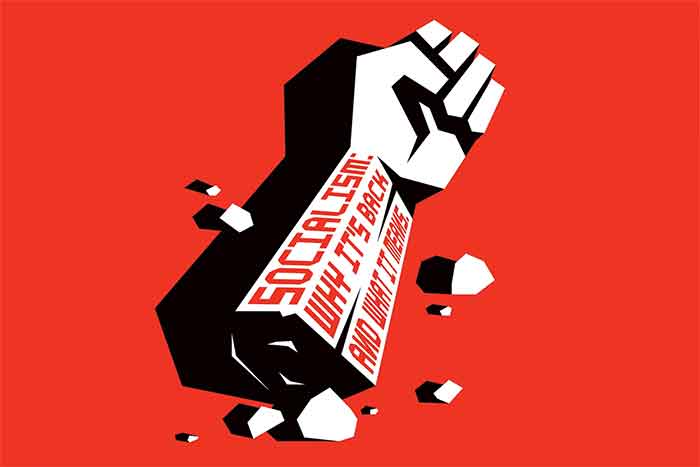An Interview with the Editor of ‘The New Socialist Reader’

Reader: What are the aims of your journal?
Editor: As the bold lines at the bottom of every page in our journal says:
Our short term goal is to unionise all the working classes.
Our long term goal is to achieve socialism.
R: What are the main issues you take up in your journal?
E: Every issue of our journal carries material to help educate the working class in the ideas of New Socialism.
R: What is New Socialism?
E: It is the ideas of socialism relevant to our times.
R: What do you share with the old ideas of socialism?
E: Almost everything with a few differences that arise due to the new conditions that have arisen. The main slogans cited above are the same as of old socialism. We definitely share the principles of equality, brotherhood and freedom, the ideas that came originally from the French Revolution. Secondly we shares most of the ideas of Marx – like the society is composed of classes with antagonistic relations and that the class struggle is the motor of history and so on. Hence we give the slogan about unionising all the working classes.
We also share the ideas that socialism will lead to communism and anarchism. The traditional slogan about transformation from socialism to communism is ‘from each according to his abilities to each according to his needs ’. The slogan for anarchism is ‘A free association of a free people’ with emphasis on freedom and self managed local communities federating with other such communities.
R: What is your assessment of the old ideas of socialism?
E: The old socialism achieved a lot of things and failed in a lot of things. We inherit both. We have to build on the achievements and learn from the failures.
R: What were the main achievements?
E: First and foremost was their courage to dream of a new future, struggle for it and partially succeed. The struggle was carried out in the field of theory, in the hard work involved in organizing the working classes; carry out the revolution and the struggle to save the socialist experiment from the continuous onslaught of capitalist forces from within and outside.
Secondly they inspired the whole world, particularly in the colonies to fight against imperialism. The Indian freedom movement as well as the anti colonial struggle all over the world was inspired by the success of the Soviet Union. Even in the capitalist countries the idea of the welfare state came from the soviet inspiration and struggle of the working people in those countries.
Later in the late sixties of the last century China, Vietnam and Cuba inspired the revolutionary movements in many parts of the world including the Naxalite movement in India.
R: What were the failures and what were the reasons?
E: The failures were obviously that they could not retain and proceed further on the road to socialism. There is a very large debate on the reasons of failure. It is difficult to distinguish the mistakes that were historically inevitable and those that could have been avoided.
For example many argue that socialism in one country cannot last unless rest of the world follows. Stalin argued for socialism in one country. But today we have to ask, even if Stalin was wrong, should the Soviets not have tried it out? In spite of the many sacrifices involved? Don’t we daily fight losing battles? Lenin once said that the proletarian revolution is a successful culmination of a series of failures. The point is that we cannot turn the clock back and that today we have to build on the successes and learn from the failures.
R: So what were the specific failures that we have to learn from?
E: Many people believe that the idea of socialism in one country led to a series of mistakes. In order to fight the capitalist/imperialist encirclement the party had to shed democracy to a significant extent and became dictatorial. They suspected real and imaginary enemy agents within the party and carried out purges that led to death of many good communists and ordinary people. Many genuine differences were regarded as anti party activities. This legacy unfortunately, plagues many communist parties all over the world even today and erodes their credibility.
Secondly their choice of technology and organization of industry was same as those of capitalist countries in spite of the fact that many contemporary anarchists like Kropotkin argued against it. That is, it is based on hierarchy, power and division of labour. Although unions and factory committees were there they could not avoid the situation of power and lack of democracy.
Thirdly their belief in what we today call ‘infinite resources and an infinite sink’. That is, they believed that there is no dearth of resources on the earth and if we can avoid wars and capitalist wasteful consumerism every one can live in great comfort and enjoy the fruits of modern technology. By infinite sink it is meant that the earth can absorb pollutants without limit. Both as we know today are wrong.
R: So what is new in New Socialism?
E: The new ideas of socialism come from three sources:
- A critic of the past,
- An awareness of the new conditions and
- An awareness of people’s movements in response to the new conditions.
R: So what would the new socialism look like?
E: Let me give the main component ideas of the new socialism:
- Equality
- Scaling down the level of energy
- Local self sufficiency
As you see the first component is same as old socialism. The second and the third are the new ones.
R: What is the reason for these new components?
E: The component about scaling down the energy comes from the new conditions that have arisen. The first is global warming. The scale at which the world is consuming energy is causing emissions of carbon dioxide which is causing the global warming. The levels are such that all life on earth is endangered and the consumption has to come down immediately. As it is, the effects of what has already happened will continue for decades.
R: But once there is socialism all over the world, wars and irrational capitalist consumerism will reduce the consumption of energy and won’t there be plenty for all?
E: Yes it is a desirable goal but there is neither enough time nor enough resources. The available sources of fossil fuels are declining and a phenomenon called ‘peak oil’ has occurred. This means the production of oil will keep on declining. Same will happen to gas and coal. Still there will be ‘plenty for all’ if we plan in such a way that not only wars and capitalist irrational consumerism are eliminated but the transport needs are drastically reduced. That is replacing the present trend of globalization with localization. That is where the third component of local self sufficiency comes from.
R: But the present specialization and globalization has given good results. Vast quantities of wheat are grown in Punjab, USA and Australia and are very efficiently and exported all over the world at very cheap rates. It has also reduced the drudgery of old kind of farming and freed a lot of people to enjoy luxuries.
E: I am afraid this is based on misinformation. First the so called efficient production is not true. Capitalist large scale farming takes a lot of inputs in terms of mechanization and fertilizers and pesticides and based on availability of cheap fossil fuels. It also reduces the fertility of the soil.
There is an essential difference between agriculture and farming. Agriculture by definition produces all its inputs on the farm itself including the human and animal power. Therefore it will always be more efficient than capitalist farming. Farming is like an industry; it takes in ‘raw material’ and processes it with energy and produces an output. With fossil fuels depleting and getting expensive and with the fall in fertility, capitalist farming will become unviable and disastrous.
R: Are you talking about going back to the olden golden days?
E: I am afraid there were no pure olden golden days. It is true that capitalism, with its enormous exploitation of working classes and natural resource have turned the planet Earth to look like hell and people do talk of ‘regaining paradise’. There are many groups, mainly from middle class who are aware of this ecological disaster, who have set up organic farms and they try to live a simple life.
R: So what is wrong with it?
E: The old order was part of a feudal order. There are many things that have changed permanently. One is that our sensibilities, particularly our desire for freedom, breaking down of the joint family and other aspect of the feudal world have gone forever. However this new freedom is based on having money which itself is obtained by wage slavery! The challenge is to combine our new sensibilities of freedom without wage slavery and a society based on lower scale of energy.
R: How can we achieve this?
E: The idea of small groups working together is not bad. But it should be based on ‘a free association of free people’ and not on joint family or wage slavery. Secondly the technology may use less energy but it will not be old or primitive. It will have to be knowledge based technology using lesser energy – mainly based on biological harvesting of solar energy. The phrase “perennial polyculture’ of Permaculture is the key concept. A more general term would be agro-ecology. Cuba is leading in this technology.
However it will also have to cater to our current sensibilities – dalit, feminism, tribal heritage and wild life. Also books, films and internet will be there.
R: What are the new movements that call for the new socialism?
E: There are three kinds of movements that are going on in India. They are:
- The movements led by communists of different shades. They include the normal trade union movements. In trade union movements, the new movements are those of the unorganized sectors like MNREGA workers, municipal workers, sex workers etc. Then there are movements like the Maoists and other Naxalite groups that have an explicit revolutionary agenda. Most of these are led either by non party political organizations or political parties that are outside the election politics. Today elections are almost always fought with money donated by the capitalist class and the parliamentary parties have by and large become anti people.
- Then there are identity and/or separatist movements like Kashmir or North East, but they also include movements for smaller states like Telangana or Vidarbha.
- There are movements against large dams, thermal power plants (coal, gas and nuclear), petro-chemicals and SEZs, large steel and aluminium plants. Most of these are led by peasants and poor rural people who are going to lose land or livelihoods. But they are supported by networks like NAPM and by local concerned and environmentally conscious citizens. While by and large they failed to achieve their tangible goals, they have raised the consciousness of millions of people about evils of capitalist development.
R: How do they add to the agenda of the new socialism?
E: Traditionally the socialist movement was with the organized sectors of the working class, which meant people from upper castes and middle castes. The unorganized sector includes dalits, tribals, poor women and Muslims. So today, the movement is including a greater number and different kinds of working class members. The revolutionary movement is mainly concentrated among tribals of central India. This also represents new entrants. Finally almost everyone has lost faith in elected representatives and the struggle is increasingly outside the so called ‘democratic’ framework.
The identity movements reflect the federal nature of Indian reality. This nicely couples with the need for local self sufficiency agenda.
The anti big projects people’s movement are, at once against capitalism as well as against technological solutions of the old type. When people fight for their land they are fighting for food and energy security. Agriculture also represents harvesting solar energy through photosynthesis as against getting electricity from fossil fuels through thermal power plants. The power plants provide electricity mainly to the city people and industry.
R: So how does the new socialist agenda look like?
E: We can sum it as follows;
- It is abolishing of capitalism and all forms of exploitation of man by man.
- It is based on equality.
- Its technological base will be consumption of much lower level energy coming mainly from harvesting the sun biologically.
- Politically it will be composed of states federated with each other on the basis of mutual support and equality.
- Each of these states will be as far as possible locally self sufficient.
R: Who will lead the revolution?
E: The traditional understanding was that it would be the industrial working class led by the communist party. The reason was that the working class was the antithesis of capitalism. The industry creates and organizes the working class for its own needs. However later it became clear that globally several forms of modes of productions coexist under capitalism and the workers in older forms of production are more exploited. Even in Russia it was an alliance of the workers and peasants. In China and Vietnam it was clearly a peasant revolution. Today as we have seen above a diverse sections of the working classes are involved in struggling against capitalism.
The communist parties are also changing character. It would appear that the members will have to be steeled in a large variety of class struggles – unions, mass movements, guerrilla armed struggles and theoretical understanding of history of the movements. They will also have to acquire ability to work with other movements on the basis of equality and sharing resources.
R: What is the situation in India?
E: In India there is a large scale revolutionary movement led by the Communist Party of India (Maoist). However there are several important criticisms of this party.
These are:
- They do not have dialogue with other revolutionary groups and some time they violently kill the members of other groups calling them informers.
- Their ideas of socialism are mainly of the old kind of socialism though they are aware of some of the new issues.
R: What should be done?
E: I think we should keep on urging for a dialogue among all the concerned groups and people and arrive at a realistic new programme. That alone will ensure success.
R: Thank you very much. I suppose it is up to us, the younger generation to fulfil the dreams of the Indian people.
Notes
- This was written for a veteran Marxist trade unionist who has a Gandhian background. Hence the format of ‘Editor and Reader’ which is borrowed from Gandhi’s Hind Swaraj.
- The journal ‘The New Socialist Reader’ obviously does not exist. There are several journals like this in India including Mainstream and Frontier. But I could not have put words in their editor’s mouth!
T. Vijayendra (1943- ) was born in Mysore, grew in Indore and went to IIT Kharagpur to get a B. Tech. in Electronics (1966). After a year’s stint at the Saha Institute of Nuclear Physics, Kolkata, he got drawn into the whirlwind times of the late 60s. Since then, he has always been some kind of political-social activist. His brief for himself is the education of Left wing cadres and so he almost exclusively publishes in the Left wing journal Frontier, published from Kolkata. For the last nine years, he has been active in the field of ‘Peak Oil’ and is a founder member of Peak Oil India and Ecologise. Since 2015 he has been involved in Ecologise! Camps and in 2016 he initiated Ecologise Hyderabad. He divides his time between an organic farm at the foothills of Western Ghats, watching birds, writing fiction and Hyderabad. He has published a book dealing with resource depletions, three books of essays, two collections of short stories, a novella and an autobiography. Vijayendra has been a ‘dedicated’ cyclist all his life, meaning, he neither took a driving licence nor did he ever drive a fossil fuel based vehicle. Email: [email protected]
Published in Mainstream, VOL 62 No 6 February 10, 2024
A Dialogue on New Socialism An Interview with the Editor of ‘The New Socialist Reader’ | T. Vijayendra















































